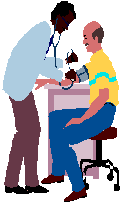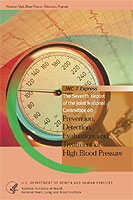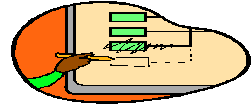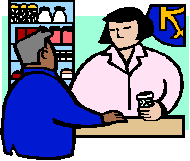DOH Medicaid Update December 2003 Vol.18, No.12
Office of Medicaid Management
DOH Medicaid Update
December 2003 Vol.18, No.12
State of New York
George E. Pataki, Governor
Department of Health
Antonia C. Novello, M.D., M.P.H., Dr. P.H.
Commissioner
Medicaid Update
is a monthly publication of the
New York State Department of Health,
Office of Medicaid Management,
14th Floor, Room 1466,
Corning Tower, Albany,
New York 12237
Table of Contents
HIPAA News: HIPAA-Compliant Transactions Now Accepted
HIPAA News: Omni 3750 Deployment Continues
HIPAA News: HIPAA Trading Partner Agreement Reminder
HIPAA News: Providers Are You HIPAA Compliant?
HIPAA News: Important Reminders For All Providers
Provider Reminder: 1099 Forms
Durable Medical Equipment Providers: Revised Fees For Knee Orthotics
Traumatic Brain Injury Waiver Rate Changes
Where Can I Access The List Of Medicaid Reimbursable Drugs?
Medicaid Prescription Requirements
HIPAA News: Requirements Regarding Disclosing And Using Health Information For Medicaid Enrollees
Addition To List Of Primary Care Referrals For Recipients Of The Family Planning Benefits Program
What Is Asthma?
Patients With Diabetes Heed Their Doctor's Advice
Payment For Psychiatric Social Work Services In Federally Qualified Health Centers
Ask The Pharmacist: Return of Unused Medication
YOU MAY NOW ENROLL IN ePACES
Return to Table of Contents
Previous editions of the Medicaid Update introduced information about the Electronic Provider Assisted Claim Entry System (ePACES), the HIPAA-compliant replacement for the current PACES and Eligibility Field software. ePACES is a web-based application that is available via the Internet, at no cost to providers. ePACES enrollment became available in September 2003; since then over 9,000 providers and submitters have successfully completed the enrollment process.
What functions does ePACES support?
- Client Eligibility/Service Authorization/Dispensing Validation System Inquiry and Response (HIPAA transactions 270, 271, and 278)
- Claim Status Inquiry and Response (HIPAA transactions 276 and 277)
- Claims (HIPAA transactions 837 Dental, Institutional, and Professional)
What are the benefits of ePACES?
- ePACES is available free of charge.
- Allows submission of HIPAA-compliant transactions.
- Allows submission of claims and eligibility transactions without having two different applications on your computer (ePACES replaces the current PACES program and the Eligibility Field Software).
- ePACES is a free alternative to the POS Device.
- ePACES is convenient and user friendly. Navigation includes data entry fields and pop-up boxes that encourage speed and accuracy.
You must complete the ePACES enrollment process in order to use the ePACES application, even if you currently use PACES or the Medicaid Eligibility Field Software.
For detailed instructions on enrollment, please visit the following website: www.emedny.org/hipaa/quickrefdocs/index.html (document entitled "FOD-4002 ePACES Enrollment). After reviewing the enrollment procedures, go to www.emedny.org/enroll to complete the process.
What to expect during the enrollment process:
Part 1 - Enrolling Providers
- Be ready with Provider ID and Token when accessing the enrollment website. (If you did not receive a Token, call 800-522-5518.)
- After entry of Provider ID, Token and acceptance of the Medicaid Confidentiality Agreement, enter and verify a valid e-mail address.
- The Provider User ID will be displayed on your screen: KEEP this in a safe place. Within 4 hours, ePACES sends e-mail to Provider with password and instructions.
- Provider logs onto enrollment screen again and replies to ePACES email by placing the token, with no other text, in the subject line of the response. ePACES sends acknowledgment.
- Provider logs onto enrollment screen again and enters Provider ID and password into the system. ePACES displays screens to allow the Provider to register Submitters, by TSN.
- Provider logs out and retains User ID and password.
Part 2 - Identification of Submitters and Administrative Set Up
- ePACES sends email to Submitter with the Submitter's User ID and notification of the specific Provider that registered them as a Submitter.
- Submitter replies via email with the Submitter User ID, with no other text in the subject line of the response.
- ePACES sends email to Submitter welcoming them to ePACES and grants access to ePACES Application as an Account Administrator
(= Submitter). - Submitter logs onto ePACES using the Submitters User ID and initial password. ePACES prompts Submitter to change password.
- Once password is changed, ePACES acknowledges logon. Submitter/Administrator sets up User Accounts, (by selecting "User Admin" on the Menu Bar), with Submitter User ID and password.
- ePACES acknowledges account set up.
When you are enrolling, please be aware of the following:
- Do not confuse the term Provider with the term Submitter. The Provider is the actual provider of service to the client. The Submitter can be the provider or a third party that submits on their behalf.
- Do not confuse your initial token and password with your permanent User ID and password.
- Your initial token is not case sensitive; however, your permanent User ID and password is case sensitive.
- Be sure to use one consistent, valid email address for all ePACES correspondence.
- Submitters must complete the administrative portion of the enrollment process. (The Submitter User ID is different from the Provider User ID even if the Provider is the Submitter.) Be sure to designate a secondary System Administrator as a back up.
If you are interested in using ePACES, please visit the above referenced websites or call:
For ePACES Enrollment and Claims Transactions - (800) 522-5518
For questions regarding Eligibility Transactions - (800) 343-9000
HIPAA
NEWS
HIPAA COMPLIANT TRANSACTIONS NOW ACCEPTED
Return to Table of Contents
The New York Medicaid Management Information System (MMIS) now accepts and processes the following HIPAA-compliant claims transactions:
- 837 (claims),
- 835 (payment advice),
- 270 and 271 (eligibility inquiry and response),
- 276 and 277 (claim status request and response),
- 278 (service authorization); and,
- NCPDP 5.1 (retail pharmacy claims).
Medicaid's deployment of its HIPAA compatible system will not affect trading partners' ability to continue submitting claims in current proprietary electronic formats. For the period of November 6, 2003 through February 18, 2004, Medicaid will operate a bilingual claims processing system, with the ability to accept and process both the current proprietary MMIS claim formats and the HIPAA formats. All present MMIS claims processing functionalities will be maintained, including TRANZ 330 terminals and field eligibility software.
The main purpose for operating a bilingual system is to provide a transition period for those trading partners still working toward achieving HIPAA compliance. A bilingual system will allow you to proceed with your compliance efforts without disruptions in claims processing or payments.
Trading partners who wish to test their claim submission software will have additional testing opportunities. Information on additional testing opportunities is available at www.eMedNY.org Trading partners that have not yet registered to test with Edifecs are encouraged to do so at:
Trading partners must test successfully through Edifecs before submitting test files using the "Test/Production Indicator" on the 837 transaction.
During the transition period of November 6, 2003 through February 18, 2004, New York Medicaid will closely monitor Edifecs registration and testing activities. Trading partners are expected to work aggressively toward achieving HIPAA compliance within that timeframe. The transition period should be used to complete compliance activities.
After February 18, 2004, the Medicaid program will only accept and process HIPAA-compliant transactions.
If you have any questions related to Medicaid's HIPAA compliance requirements or need technical clarifications, please contact the CSC HIPAA Inquiry Unit at (800) 522-5518.
HIPAA
NEWS
OMNI 3750 DEPLOYMENT CONTINUES
Return to Table of Contents
Since the rollout began in July, thousands of new Omni 3750 POS devices have been installed in Medicaid provider locations. As of late September, the HIPAA-compliant POS software has been available for downloading on all Omni 3750s, enabling providers to submit HIPAA-compliant transactions. If you have not yet ordered your Omni 3750 to replace your current Tranz 330, be aware that Tranz 330 transactions will not be accepted on and after February 18, 2004. To ensure your ability to confirm client eligibility, obtain service authorizations, and perform other POS transactions, you must have an Omni 3750 by this date or switch to an alternate access method, such as ePACES (see above, "You May Now Enroll in ePACES").
PRICING AND FEATURES OF THE OMNI 3750
The Omni 3750 is priced at $817 (includes shipping and handling) plus tax, and includes features such as: five year warranty on hardware failures; Expedited Replacement Service (overnight replacement of damaged units); integrated thermal printer; faster 14,400 bps modem for improved transmission speeds; and easier to use ATM keys.
In August 2003, letters containing instructions and forms for ordering the Omni 3750 were mailed to providers submitting transactions via a POS device. If you are a POS user and did not receive a letter, please call the Provider Services POS Inquiry Line at (800) 343-9000 (Option 4). This line is available Monday through Friday between 9:00 AM and 5:00 PM.
Providers with internet access can also obtain this information at www.emedny.org under "What's New."
OMNI 3750 FREQUENTLY ASKED QUESTIONS
- Q. What is Service Type Code?
- A. This code defines the classification of service the provider is performing. During processing, the eMedNY system will take the service type code entered on the MEVS transaction and map it to the appropriate Category of Service/Specialty Code combination that is on the provider's file. Although this is not a mandatory entry on a "Tran type 2" eligibility-only transaction, Hospital and Clinic Providers are encouraged to enter a Service Type to further define the service they are providing, and ensure that the correct restriction information is returned. On the "Tran Type 1, 6, or 7," the Service Type is used to determine SA, DVS and Co-pay assignment. If there is no Service Type to map, the provider may not get the expected result. For Hospital and Clinic Providers, entry of a Service Type on a "Tran Type 1" transaction is required. A complete list of Service Type Codes can be found in the EQ Segment of Loop 2110C in the Companion Guide of the 270 Eligibility Only Transaction.
- Q. What is a Taxonomy Code?
- A. The function of the Taxonomy Code is the same as the Service Type Code.
- Q. Can I use my Omni 3750 for Credit Cards?
- A. No, the Omni 3750 MEVS device does not currently support multiple applications.
- Q. What's the slot on the front of the Omni 3750?
- A. The slot on the front of the device is designed for Smart Cards; at this time the Medicaid program has not offered the Smart Card to Medicaid clients.
- Q. Does the Omni 3750 need ink refills?
- A. No. The Omni 3750 has thermal pins that heat up and burn into the special thermal paper.
- Q. Where do I get paper refills?
- A. Thermal paper can be purchased at any office supply store (2 1/4" X 85', Part Numbers CRM0039 or CRM0040).
For further information on set-up instructions and information pertaining to prompts and responses, please refer to the new eMedNY MEVS Provider Manual at www.emedny.org under "manuals."
HIPAA
NEWS
HIPAA TRADING PARTNER AGREEMENT REMINDER
Return to Table of Contents
A TRADING PARTNER AGREEMENT (TPA) must be submitted by each provider enrolled in the New York Medicaid program that plans to submit electronic claims after HIPAA implementation. Additionally, Transmission Supplier Number (TSN) owners that will use the TSN as the ISA06 value for HIPAA transactions must complete a TPA for the TSN.
This TPA is available at www.nyhipaadesk.com, find the "News and Resources" tab. The TPA should be completed with either your Provider ID Number and/or your TSN. Page 1 and 4 of the TPA must be fully completed, including an original signature on Page 4. All four pages of the TPA must be mailed to the following address:
Computer Sciences Corporation
Attn: TPA Coordinator
800 North Pearl Street
Albany, NY 12204
Questions about TPA completion should be directed to CSC at (800) 522-5518 or (518) 447-9860.
HIPAA
NEWS
PROVIDERS: ARE YOU HIPAA COMPLIANT?
Return to Table of Contents
As noted in the November 2003 Medicaid Update, the Department of Health's contingency plan to avoid disruption in claims processing and payment flow to providers who were not able to fully achieve compliance with the Health Insurance Portability and Accountability Act (HIPAA) transaction standards by the October 16 deadline is now in effect. That plan, based on federal guidance issued in July, has been described in recent Medicaid Updates, and in a letter mailed four months ago to providers who bill electronically. Trading partners - providers, vendors and clearinghouses - may, for a short transition period, continue to submit Medicaid proprietary (non-HIPAA-compliant) transactions while aggressively working toward full HIPAA compliance.
Until February 18, 2004:
- Medicaid will continue to accept and process the current Medicaid proprietary formats (as well as HIPAA-compliant transactions).
- Trading partners must continue to make every effort to migrate to HIPAA-compliant transaction submissions.
- Trading partners will be expected to comply with Medicaid's open testing process outlined at www.nyhipaadesk.com.
- Providers may continue to use the current PACES (Provider Assisted Claim Entry System) or the Medicaid Eligibility Software, but are urged to convert to the HIPAA-compliant ePACES software, which is available free of charge. Information on ePACES may be found on the web site www.emedny.org and in the accompanying article, "You May Now Enroll in ePACES."
- TRANZ 330 POS devices will continue to be supported.
- Providers who have not ordered their replacement device, the VeriFone Omni 3750, should do so immediately (or switch to an alternate access method, such as ePACES). For ordering and other information, please see the accompanying article, "Omni 3750 Deployment Continues".
After February 18, 2004:
- All electronic transaction submissions must be HIPAA-compliant. Electronic claims submitted in a non-HIPAA-compliant format will be rejected.
- TRANZ 330 devices will no longer be supported. The only POS devices that will be supported will be the VeriFone Omni 3750.
- PACES and the Medicaid Eligibility Software will no longer be supported. ePACES will be supported.
This contingency plan is intended to enable the New York State Medicaid program to continue the processing claims and payments to providers who have not been able to achieve full compliance, while aggressively continuing to work with them to become compliant through active outreach and testing.
Questions regarding HIPAA Medicaid compliance and this article may be directed to CSC's HIPAA Support Helpline at (800) 522-5518.
HIPAA
NEWS
IMPORTANT HIPAA REMINDERS FOR ALL PROVIDERS
Return to Table of Contents
Many of the processes used in the Medicaid Management Information System have been redesigned to accommodate HIPAA transaction processing. Computer Sciences Corporation (CSC) previously sent the following change notices to providers and service bureaus. Please read each of the following items to see if you are impacted and, if yes, have you taken appropriate action?
- Providers who currently receive TAPE REMITTANCES were mailed a form to return to CSC, to request a HIPAA-compliant tape remittance, after HIPAA implementation (835-remittance format or the 835 plus a supplemental file, or 820 or 820 plus a supplemental file for managed care plans). To obtain a copy of this form, please contact CSC's EMC Control Unit at the telephone number below. This form should only be returned to CSC when you are ready to receive the HIPAA 835 or 820 tape remittance.
- Providers that have claims submitted using multiple ETINs (or TSNs as they are known today) were mailed a form to return to CSC, to notify CSC of your choice for PRIMARY ETIN. The purpose of choosing a primary ETIN is to direct check-balancing information to the appropriate ETIN receiving a provider's tape remittance. All non-primary ETINs that get a tape remittance will continue to receive claim information for those claims submitted with that non-primary ETIN, but check-balancing information (and retro-active rate adjustments for rate-based provider) can only be directed to one ETIN (the primary). Please note that you MUST be linked to the chosen Primary ETIN via a Certification Statement for Electronic Billing. If this impacts you, please contact CSC's EMC Control Unit at the telephone number below to obtain a copy of the Primary ETIN Selection Form.
Note: Check information will still be available on the paper check stub. - Providers and Service Bureaus that will submit HIPAA EDI claims or NCPDP claims on tape, diskette or cartridge were mailed new TRANSMITTAL FORMS that must accompany each tape or diskette submission. The HIPAA EDI transmittal forms are gray. NCPDP claims that will be submitted on tape or diskette must be accompanied by a new orange transmittal form. There is a version of both the gray and orange Transmittal Forms for providers and a separate version for service bureaus. IT IS IMPORTANT THAT THE CORRECT COLOR FORM BE USED. These forms must NOT be sent with your proprietary claim data. They are to be used when you begin sending data in the HIPAA EDI or NCPDP data formats. To obtain a supply of these new transmittal forms, please contact CSC's EMC Control Unit at the telephone number below.
Please note: You must continue to use the current "white" MMIS Transmittals for proprietary-formatted claims submitted on tape, diskette or cartridge.
- A notice was displayed on the electronic Medicaid Gateway, alerting electronic submitters that in order for the Medicaid Gateway menu to offer a HIPAA EDI choice, submitters must contact CSC's EMC Control Unit, at the telephone number below, to request that menu choice be established for your logon. If you do not call to make the request, only the proprietary options will be visible to you on the menu and you will not be able to submit HIPAA EDI claims. You should only request the HIPAA menu option when you are ready to transmit HIPAA EDI data.
Questions about any of the information in this letter should be directed to CSC's EMC Control Unit at: (518) 447-9256
PROVIDER REMINDER: 1099 FORMS
Return to Table of Contents
Computer Sciences Corporation (CSC), as fiscal agent for the New York State Department of Health, issues 1099 forms to providers at the beginning of each year for the previous year's Medicaid payments. The check amounts that total the yearly amount are not based on the date of the checks; rather, the yearly amount is based on the date the checks were issued to providers.
Due to the two-week check lag between the date of the check and the date the check is issued, the 1099 amount will not correspond to the sum of all checks issued for your provider ID based on the check date. The 1099 amount is based on check issue date.
For 1099s that will be issued for the year 2003, the checks issued are as follows:
- Check dated 12/16/02 (Cycle 321) issued on 01/02/03 through,
- Check dated 12/15/03 (Cycle 373) issued 12/31/03
Additionally, if group practice providers want to direct Medicaid payments to a group ID and corresponding 1099, they must submit the group ID number in the appropriate field on the claim (paper or electronic). Claims that do not have the group ID entered will cause payment to go to the individual provider and his/her 1099.
1099s for the year 2003 will be mailed no later than January 31, 2004.
The above information is provided to assist providers reconcile their 1099 amounts. Any questions should be directed:
CSC Call Center (800) 522-5518 or (518) 447-9860
Pharmacies should contact eMedNY Provider Services at (800) 343-9000
DURABLE MEDICAL EQUIPMENT PROVIDERS
Return to Table of Contents
REVISED FEES FOR KNEE ORTHOTICS
Effective for dates of service on or after January 1, 2004, please make the following fee changes on pages 4-57 & 4-58 in your MMIS Durable Medical Equipment Provider Manual (Rev. 4/03).
| Code | New Fee 1/1/04 |
|---|---|
| L1815 | $ 65.63 |
| L1825 | $ 37.25 |
| L1832 | $ 549.18 |
| L1834 | $ 595.41 |
| L1843 | $ 634.53 |
| L1844 | $1,107.70 |
| L1847 | $ 406.75 |
| L1870 | $ 873.77 |
Questions may be referred to the Bureau of Medical Review and Payment at (518) 474-8161.
TRAUMATIC BRAIN INJURY WAVIER RATE CHANGES
Return to Table of Contents
The New York State Department of Health is pleased to announce a change in certain rates for the Home and Community-Based Waiver/Traumatic Brain Injury Waiver (HCBS/TBI Waiver), Category of Service 0263, effective December 1, 2003:
Substance Abuse Program (Rate Code 9859):
- Effective December 1, 2003, the rate will change from a daily rate to an hourly rate. The hourly rate is $34 an hour, for a maximum of 5 hours per day.
Structured Day Program (Rate Code 9870):
- Effective December 1, 2003, the rate will change from a half-day rate to an hourly rate. The hourly rate is $15.60, for a maximum of 8 hours per day.
These changes do not result in any change in reimbursement.
Questions may be referred to Marcia Anderson in the Bureau of Long Term Care at (518) 474-6580.
WHERE CAN I ACCESS THE LIST OF MEDICAID REIMBURSABLE DRUGS?
Return to Table of Contents

The list of Medicaid reimbursable drugs is now available on the Medicaid website:

http://www.health.state.ny.us
Find Info for Providers, Medicaid, eMedNY website, Information, Formulary File
The list of Medicaid reimbursable drugs will no longer be mailed to providers. Please download the information.
If you have any questions, please contact the pharmacy staff at (518) 486-3209.
Information
For Pharmacists
and
Prescribers
MEDICAID PRESCRIPTION REQUIREMENTS
Return to Table of Contents

All prescriptions/fiscal orders written for Medicaid recipients must bear:
- the name, address, age and client identification number (CIN) of the patient for whom it is intended;
- the date on which it was written;
- the name, strength, if applicable, and the quantity of the drug prescribed;
- directions for use, if applicable; and,
- the name, address, telephone number, profession, license number or MMIS provider identification number, DEA number, if applicable, and signature of the prescriber. In addition to the signature, the prescription/fiscal order must be imprinted or stamped legibly and conspicuously with the printed name of the prescriber who has signed the prescription/fiscal order.
- If the prescriber requires that a brand name drug be dispensed, he/she must write DAW "dispensed as written" on the prescription form. For certain Medicaid brand name prescriptions, prescribers must also certify that they require the brand name drug by writing on the face of the prescription, "brand medically necessary", in their own handwriting.
For non-controlled substance prescriptions, the pharmacist may record on the prescription the address and age of the patient, the strength and quantity of the drug prescribed, the directions for use and the prescriber's address, telephone number and profession if these are missing or unclear. If the address, age or CIN of the recipient are missing, the pharmacist is not required to enter any of these items on the prescription if the information is otherwise readily available in the records of the pharmacy and the filling pharmacist knows the person who is requesting that the prescription be filled or is otherwise satisfied that the prescription is legitimate.
Prescriptions written for controlled substances must meet the requirements of Article 33 of the Public Health Law. In accordance with NYSDOH Rules and Regulations (Part 80), pharmacists are permitted to add or change only certain information on controlled substance prescriptions, including the Official New York State Prescription.

Who May Prescribe Drugs and Order Medical/Surgical Supplies
Physicians, certified nurse practitioners and midwives, dentists, podiatrists, registered physician's assistants (RPAs) and NYSED certified optometrists may prescribe/order legend and non-legend drugs, as well as medical/surgical supplies within the scope of their profession.
Registered Physician's Assistants
RPAs may write prescriptions and fiscal orders for prescription medications, over-the-counter products and medical/surgical supplies when delegated by the supervising physician. The recipient must be under the care of the physician responsible for the supervision of the RPA.
- Once registered by the DEA as a "mid-level practitioner", RPAs may write for Schedules III, IV and V controlled substances in the outpatient setting, subject to any limitations imposed by the supervising physician and/or clinic or hospital where such prescribing activity may occur.

- Such prescriptions are to be written on the supervising physician's prescription form. The prescription form must include: the imprinted name of the RPA; the imprinted name of the supervising physician; the practice address and phone number; the RPA's signature followed by the designation RPA; the RPA's New York State registration number; and the physician's license number.
- RPAs may also prescribe Schedule III, IV and V controlled substances which require the use of the Official New York State prescription form, provided these prescriptions are written on forms issued to the RPA. RPAs are not authorized to issue prescriptions for Schedule II controlled substances at any time.
Certified Nurse Practitioners and Midwives
Certified nurse practitioners and midwives may write prescriptions or fiscal orders for recipients within the Medicaid program under the following guidelines:

- Certified nurse practitioners and midwives may write a prescription or fiscal order for all legend drugs, including: Schedule II, III, IV and V controlled substances, non-legend drugs and medical/surgical supplies.
- Such certified nurse practitioners and midwifes are identified by a six-digit license number preceded by an F. This license number, the nurse practitioner's or midwife's name, office address and office telephone number must appear on the prescription blank.
- For controlled substances, the DEA number must appear on the prescription blank.
Certified Optometrists
Certified optometrists may write prescriptions and fiscal orders for recipients within the Medicaid program under the following guidelines:

- Any certified optometrist may write a prescription or fiscal order for legend, non-legend drugs and medical/surgical supplies limited to those agents as defined in Section 7101-A of the New York State Education Law.
- The optometrist's name, office address, and office telephone number must appear on the prescription blank, as well as their license number with the special privilege letter U, V and/or T that precedes their six-digit license number.
For Medicaid related questions, contact Medicaid Pharmacy Policy and Operations staff at:(518) 486-3209 or PPNO@health.state.ny.us
For non-Medicaid related questions regarding the scope of prescribing for these professionals, please contact the appropriate professional board office at:
Office of the Professions, State Education Building, 2nd Floor, 89 Washington Ave., Albany, NY 12234. Telephone: (518) 474-3817 or Web site: www.op.nysed.gov
HIPAA
NEWS
REQUIREMENTS REGARDING DISCLOSING AND USING HEALTH INFORMATION FOR MEDICAID ENROLLEES
Return to Table of Contents
In the March 2001 edition of the Medicaid Update, we provided you with background information on the health Insurance Portability and Accountability Act (HIPAA) and the administrative simplification provisions of the Act. HIPAA is a federal law requiring national standards for automated transfer of certain healthcare data between payors, plans and providers. As a provider in the Medicaid program, you will be affected by these changes

This edition of the Medicaid Update is a reminder about the privacy rule of HIPAA and provides key information on how your current business processes may be impacted. It also provides information regarding the Final HIPAA Security Regulation and the Office of Civil Rights Interim Rule on Enforcement.
______________________________________________________
Privacy Rule

The Privacy Rule of HIPAA was published in the Federal Register on December 28, 2000 and became effective April 14, 2001. Entities had two years, until April 14, 2003, to comply with the Privacy Rule provisions. Covered entities include health plans, healthcare clearinghouses and health care providers who conduct certain administrative and financial transactions electronically.
The Privacy Rule is intended to ensure the protection of individually identifiable health information and requires that patients be notified of their rights regarding disclosure of their health care information.
The privacy rule has three major purposes:
- To protect and enhance the rights of consumers by providing them with access to their health information and to control the inappropriate use of that information;
- To improve the quality of health care in the United States by restoring trust in the health care system among consumers, healthcare professionals, and the multitude of organizations and individuals committed to the delivery of care; and
- To improve the efficiency and effectiveness of healthcare delivery by creating a national framework for health privacy protection that builds on efforts by states, health systems, organizations and individuals.
Impact of the Privacy Rule
The Privacy Rules impacts entities as follows:
- Individually identifiable health information can be used or disclosed by a health plan, provider or clearinghouse solely for purposes of healthcare treatment, payment and operation.
- Healthcare providers who see patients are required to obtain patient consent before sharing their information for treatment, payment and healthcare operations.
- Patient authorization for the disclosure of information must meet specific requirements (i.e., signature of individual and date).
- Specific patient consent must be sought and granted for non-routine uses and most non-health care purposes.
- Providers and health plans generally cannot base treatment on a patient's agreement to disclose information for non-routine uses.
- Providers and health plans are required to give patients a clear written explanation of how they can use, keep and disclose their health information and patients must be able to see and obtain copies of their records.
- Patients have a right to complain to a member provider or health plan about violations of this rule or the policies and procedures of the entity in question.
- Health plans, providers and clearinghouses that violate any standard of the privacy rule will be subject to civil monetary penalties of $100 per incident, up to $25,000 per person, per year, per standard.
- Federal criminal penalties could be imposed if health plans, providers or clearinghouses knowingly and improperly disclose information or obtain information under false pretenses.
In addition to the new Privacy Rule, health information obtained from Medicaid recipients is also protected by other federal regulations. These regulations provide strict guidelines regarding the disclosure and use of health information for Medicaid enrollees. The Privacy Rule is not intended to supersede or conflict with these regulations. Instead, the Privacy Rule supplements the regulations by enhancing the rights of Medicaid recipients in addition to imposing penalties for misuse of the data.
We believe the Privacy Rule will play a vital role in the security of health information of the Medicaid population.
________________________________________________
Security Rule

The Security Rule was published in the Federal Register on February 20, 2003 and became effective on April 21, 2003. Entities have until April 21, 2005 to be in compliance.
The Security Rule is intended to establish a minimum standard for security of electronic health information. The standard will require the safeguarding of health information by all covered entities.
The Security Rule and its major purposes:
- To define administrative, physical, and technical safeguards to protect the confidentiality, integrity, and availability of electronic protected health information (PHI);
- To require covered entities to implement basic safeguards to protect PHI;
- To narrow the scope of the information to which the safeguards must be applied; and
- To provide instructions for implementing those standards.
Impact of the Security Rule
The Security Rule requires:
- Healthcare providers who see patients and other covered entities who use and transmit PHI to implement the standards as set forth in the regulation;
- Entities to set standards for the storage, transmission, access, encryption, physical and technical safeguard, and sharing of electronic PHI;
- Entities to adopt the physical and technical safeguards as put forth in the regulation;
- Entities to assure that business associates with whom they share PHI meet the same standards as set forth in the regulation; and
- Entities to develop and document policies and procedures.
The Enforcement Rule
The Enforcement Rule was published in the Federal Register on April 17, 2003 and became effective May 19, 2003. This rule is published for comments. This rule establishes the procedure for the imposition, by the Secretary of Health and Human Services, of civil monetary penalties on entities that violate standards established under HIPAA. The Department of Health seeks cooperation in enforcing the rule and will provide technical assistance to help covered entities comply with the rule. If you have a Medicaid issue, contact Mr. James Botta in the NYS Office of Medicaid Management at: (518) 473-4848. If you have a non-Medicaid issue, contact the Federal Office for Civil Rights at: Office for Civil Rights, Department of Health & Human Services, Jacob Javits Federal Building, 26 Federal Plaza, Suite 3312, New York, New York 10278: Telephone (212) 264-3313, fax (212) 264-3039, TDD (212) 264-2355.
The guidelines of the Enforcement Rule will play a vital role in informing entities of the seriousness of adhering to HIPAA standards and describes the sanctions for violating the regulation.
The Enforcement Rule:
- Promotes voluntary compliance with HIPAA provisions;
- Imposes penalties on individuals or entities who knowingly violate the HIPAA regulations if deemed liable;
- Provides for limitations on the imposition of the penalties;
- Provides procedures to collect the penalty;
- Enunciates the authority of the Secretary to settle any issue or case or to compromise any penalty during the process addressed in the rule;
- Sets forth procedures to set a Hearing;
- Provides procedures for issuing subpoenas to both the named persons and unnamed persons associated with subpoenaed entities; and
- Sets forth the procedures for Settlement, Discovery, Witness lists, Statements and Exhibits, Evidence, Fees, and other court proceedings.
Impact of the Enforcement Rule
The Enforcement Rule:
- Provides that the Secretary shall impose on any person who violates a provision of HIPAA a penalty of not more than $100 for each such violation, except that the total amount imposed on the person for all violations of an identical requirement or prohibition during a calendar year may not exceed $25,000.
________________________________________________________

The State Office of Medicaid Management plans to work closely with the provider community to ensure that these provisions of HIPAA are appropriately implemented as required. We remind providers to become familiar with the privacy rule and its potential impact on provider business processes. Additional information is available on the Web at:

http://www.hhs.gov/ocr/hipaa (Office for Civil Rights)
www.cms.hhs.gov/hipaa (Centers for Medicare and Medicaid Svcs)
www.hipaadvisory.com (HIPAA regulations)
Questions about this article can be directed to the State Office of Medicaid Management, Mr. James F. Botta at (518) 473-4848.
(Note: Some of the information in the above article is excerpted from the Medicaid HIPAA Plus newsletter published by the Centers for Medicare and Medicaid Services)
ADDITION TO LIST OF PRIMARY CARE REFERRALS FOR RECIPIENTS OF THE FAMILY PLANNING BENEFIT PROGRAM
Return to Table of Contents
Referrals to primary care for recipients of the Family Planning Benefit Program should be documented in their medical file and should be followed up with the recipient on her/his next visit.
The following facility should be added to the referral list of primary care facilities for primary care services for recipients of the Family Planning Benefit Program. This list was published in the August 2003 Medicaid Update, Vol. 18, No.8.
Monroe County:
Rochester General Pediatric Associates
1425 Portland Avenue
Rochester, N.Y.
(585) 922-2575
PATIENT EDUCATIONAL TOOLS
Return to Table of Contents

This month's patient educational tools feature articles on:
- What is Asthma?
- Patients with Diabetes Heed Their Doctor's Advice
The Medicaid program encourages practitioners to copy and distribute this information to their patients and to share them with their colleagues.
What is Asthma?
Asthma is a disease in which the airways of the lung become irritated and swollen. This reduces the amount of air that can pass through the lungs and makes breathing hard. The swelling is in the airways of the lungs all of the time, even when you are feeling fine. Although asthma cannot always be prevented, it can be controlled with the right medicine and information.
What Causes Asthma Symptoms?
Usually symptoms get started or "triggered" by something that bothers your lungs. These things are called asthma triggers. There are many triggers. The most common are:
- Allergies to pollens, mold, pets, and other things in your environment;
- Air pollution such as tobacco smoke, high ozone levels, and traffic fumes;
- Emotions, including fear, crying, and laughing;
- Exercise, especially when it leads to overexertion or in cold weather;
- Household irritants, including dust, cleaning products, and perfume;
- Illnesses such as a cold or respiratory infection;
- Medications, including some over-the-counter pain relievers;
- Weather, particularly wind and cold air.
What are Some Signs of Asthma?
- Coughing -- sometimes waking you at night;
- Wheezing -- a whistling sound during breathing (especially breathing out), which can start as a low whistle and get higher pitched;
- Difficulty breathing -- this can include shortness of breath, feeling breathless, gasping for air, difficulty breathing out, or breathing faster than usual. When breathing becomes very difficult, the skin of the chest and neck may suck inward;
- Chest tightness.
The asthma signs alone are not enough to diagnose asthma. You must see a doctor who will perform tests to make the correct diagnosis.
Can Asthma be Treated and Controlled?
Having asthma does not mean you have to stop living a normal life. The good news is that with the right treatment people with asthma can live with almost no limits on their activities. To control your asthma, you should have a good working relationship with your doctor. You need to understand your asthma treatment plan. Most individuals with asthma should be able to:
- Prevent most asthma attacks, including severe occurrences of wheezing, coughing, breathing difficulties, and chest tightness;
- Sleep at night without being wakened by these symptoms;
- Prevent all or most trips to the hospital;
- Prevent missed work or school because of asthma symptoms;
- Exercise like anyone else; and
- Find an asthma treatment plan that has minimal side effects, and that satisfies you and your family.
The Medicaid Program reimburses for medically necessary care, services, and supplies needed in the diagnosis and treatment of asthma. For information regarding Medicaid payment of these services, please contact the Bureau of Program Guidance at (518) 474-9219.
PATIENTS WITH DIABETES HEED THEIR DOCTOR'S ADVICE
Return to Table of Contents

According to a recent study published in the March 2003 Diabetes Care, people with diabetes are more likely than those who do not have diabetes to follow advice for losing weight and taking antihypertensive medications. Adults with diabetes regardless of sex and race/ethnicity, apparently listen when doctors advise them to lose weight and use medications to reduce their high blood pressure. However, people with diabetes were no more likely than those without diabetes to heed physician's advice to increase their physical activity.
Contrary to prevailing physicians' assumption that most patients are unwilling to change negative health habits and that counseling is ineffective in modifying cardiovascular disease (CVD) risk behavior, physicians' advice seemed effective in modifying some hypertension risk behaviors among people with diabetes. Controlling for other factors, hypertensive patients with diabetes were twice as likely as those without diabetes to receive advice on weight loss, exercise, and antihypertensive medications.
Hypertension is a major risk factor for cardiovascular events and is a significant contributor to macrovascular and microvascular complications of diabetes. Nearly 60 percent of adults with diabetes have coexisting hypertension, doubling their risk for cardiovascular problems. CVD is the leading cause of death for individuals with diabetes who have a twofold risk of death compared with individuals without diabetes of similar age and sex.

The Seventh Report of the Joint National Committee on Prevention, Detection, Evaluation and Treatment of High Blood pressure recommends modest weight loss and moderately intensive physical activity with and without medications as treatment for hypertension.
It is important that all members of the health care team work together to influence and reinforce instructions to improve the patient's lifestyle and blood pressure control. Motivation to make lifestyle changes improves when patients have positive experience with, and trust, their clinicians.
A copy of the JNC 7 report and educational material for your patients is available at:
The Medicaid program reimburses for medically necessary care, services and supplies for the diagnosis and treatment of diabetes and hypertension. For information regarding Medicaid coverage of services related to diabetes and hypertension, contact the Bureau of Program Guidance at (518) 474-9219.
Source: Diabetes Care 26: 602-607, 2003.
PAYMENT FOR PSYCHIATRIC SOCIAL WORK SERVICES IN FEDERALLY QUALIFIED HEALTH CENTERS
Return to Table of Contents
Effective November 1, 2003, Medicaid will pay for individual clinical social services (psychotherapy) provided by certified social workers (CSWs) in Article 28 Federally Qualified Health Centers (FQHCs), FQHC look alikes, and Rural Health Centers
The Federal Benefits Improvement and Protection Act of 2000 requires states to reimburse FQHCs for reasonable costs related to the furnishing of care. As part of our compliance with this statute, Section 86-4.9(c) of Title 10 of the Official Compilation of Codes, Rules, and Regulations of the State of New York (10 NYCRR), has been amended to permit billing for psychotherapy services provided by CSWs under the following circumstances:
- Services must be provided by a certified social worker with psychotherapy privileges on their State Education Department (SED) certification, or a CSW who is working in a clinic under qualifying supervision in pursuit of such certification.
- Payment will only be made for services that occur in sites that have been certified as FQHCs, FQHC look alikes, or Rural Health Centers by the federal Centers for Medicare and Medicaid Services (CMS). (See listing below of Federally Qualified and Rural Health Centers in New York State.)
- Billing for services rendered at part-time clinics will not be allowed.
- Payment will be permitted only for psychotherapy services. Case management, medical social services, or related services are not billable.
- Billing for group psychotherapy will not be permitted.
- The CSW must only be identified on the claim by entering his/her New York State License Number with License Type 45.
Clinical social services are defined as individual psychotherapy services provided in a Federally Qualified or Rural Health Center by: on or after September 1, 2004, a licensed clinical social worker; before September 1, 2004, by a certified social worker who has received or is working in a clinic under qualifying supervision in pursuit of a psychotherapy privileges certification by the New York State Education Department.
Billing Instructions: When the provider rendering the service is enrolled in the Medicaid Program, the MMIS Provider number should be entered in Field 31 (Service Provider ID/License No.). If the individual practitioner who rendered the services is not enrolled in Medicaid, the license number and license type of the individual provider should be entered in Fields 31 and 32 (Type) respectively.
If your clinic has been designated by CMS as an FQHC, FQHC look alike or, Rural Health Center, and your clinic name and article 28 operating certificate number is NOT on the attached listing, you should submit documentation confirming your FQHC, FQHC look alike or Rural Health Center status to:
New York State Department of Health
Bureau of Medical Review & Payment
Riverview Center, Suite 6E
150 Broadway
Albany, New York 12204-2736
Questions concerning this new policy to permit Medicaid payment for psychiatric social work services in certain Article 28 clinics should be directed to the Bureau of Policy Development and Agency Relations at (518) 473-2160.
FEDERALLY QUALIFIED HEALTH CENTERS
["Y"=FQHC; "R"=RURAL HC; "L"=LOOK ALIKE]
Return to Table of Contents
| FACILITY NAME | FQHC |
|---|---|
| ANTHONY L. JORDAN | Y |
| BEDFORD STUYVESANT FAMILY CARE CENTER | Y |
| BETANCES HEALTH | L |
| BRONX COMMUNITY HEALTH NETWORK | Y |
| BROOKLYN PLAZA MEDICAL CENTER | Y |
| BROWNSVILLE MULTI-SERVICE | Y |
| CATTARAUGUS INDIAN RESERVATION | Y |
| CHERRY VALLEY COMMUNITY HEALTH CENTER | R |
| CHARLES B. WANG COMMUNITY HEALTH/CHINATOWN | Y |
| COMMUNITY HEALTHCARE NETWORK OF BUFFALO | Y |
| COMMUNITY HEALTHCARE NETWORK-FAMILY PLANNING | Y |
| COVENANT HOUSE | Y |
| DR MARTIN LUTHER KING HEALTH CENTER | Y |
| EAST HARLEM COUNCIL FOR HUMAN SERVICES | Y |
| FAMILY HEALTH NETWORK OF CENTRAL NEW YORK | Y |
| FAMILY HEALTH CENTER OF NEWBURGH | Y |
| GENEVA B. SCRUGGS | Y |
| GREENBURG HEALTH CENTER | Y |
| GREENVILLE FAMILY HEALTH CENTER | R |
| HEALTH CENTER AT NORTHCARE | Y |
| HUDSON HEADWATERS | Y |
| HUDSON RIVER HEALTHCARE/PEEKSKILL | Y |
| HUNTS POINT MULTI-SERVICE | L |
| INSTITUTE FOR URBAN FAMILY HEALTH/SIDNEY HILLMAN CENTER | Y |
| JOSEPH B. ADDABBO | Y |
| LIONEL R. JOHN/SENECA NATION | Y |
| LYNDON BAINES JOHNSON HEALTH COMPLEX | Y |
| MIDDLETOWN COMMUNITY HEALTH CENTER | L |
| MINEVILLE HEALTH CENTER | R |
| MONSEY FAMILY HEALTH CENTER | L |
| MORRIS HEIGHTS HEALTH CENTER | Y |
| MT VERNON NEIGHBORHOOD HEALTH CENTER | Y |
| NORTHERN OSWEGO COUNTY HEALTH SERVICES | Y |
| NORTHWEST BUFFALO COMMUNITY | Y |
| OAK ORCHARD COMMUNITY HEALTH CENTER | Y |
| ODA PRIMARY CARE HEALTH CARE CENTER | Y |
| ONEIDA INDIAN NATION | Y |
| OSSINING OPEN DOOR ASSOCIATION | Y |
| RUSHVILLE HEALTH CENTER | Y |
| SCHENECTADY FAMILY HEALTH CENTER | Y |
| SETTLEMENT HEALTH | Y |
| SMITH HOUSE HEALTH CARE CENTER | R |
| SOUNDVIEW HEALTH CENTER | Y |
| ST. REGIS MOHAWK NATION | Y |
| SUNSET PARK FAMILY-LUTHERAN | Y |
| SYRACUSE COMMUNITY HEALTH CENTER | Y |
| TRI COUNTY FAMILY MEDICINE | R |
| URBAN HEALTH PLAN | Y |
| WESTSIDE HEALTH SERV/WOODWARD HEALTH CENTER | Y |
| WHITNEY M YOUNG JR. HEALTH CENTER | Y |
| WILLIAM F RYAN COMMUNITY HEALTH CENTER | Y |
Return to Table of Contents
In response to inquiries regarding the August 2003 Medicaid Update article, "Return of Unused Medication", the following information is intended to clarify questions related to this topic.

Regulation Highlights
Department regulations (10 NYCRR 415.18(f)), as cited in the August 2003 Medicaid Update article, require that nursing home facilities have established policies and procedures for the return of unused medication to their vendor pharmacies. The regulation further requires that vendor pharmacies reimburse or credit Medicaid for unused "pass through" medication that is restocked and redispensed. Compliance with the regulation is mandatory and is enforced by audit. This regulation applies to all nursing home facilities regardless of payor and is not solely a Medicaid regulation.
Claim Reversals and Adjustments/Rebills

Regarding the correction of billings for drugs returned to the pharmacy, the current Medicaid system is capable of processing rebill/adjustment transactions, as well as reversal transactions.
If you are using the NCPDP 3.2 format to bill Medicaid claims, please refer to the ProDUR/ECCA Provider Manual, Sections 2.6, 7.0 and the ProDUR/ECCA Standards Manual, Section 2.9, available at www.emedny.org

If you are using NCPDP 5.1 format, the NYSDOH Office of Medicaid Management National Council for Prescription Drug Programs (NCPDP) Companion Guide (Version 5.1) should be used. The NCPDP Companion Guide is available at www.hipaadesk.com/?nymedicaid. Find the "News & Resources" tab, then the NYSDOH Companion Guides, then National Council for Prescription Drug Programs (Modification date 9/15/03). Find File Attachments NCPDP Request CGV1.7.pdf and reference the pages for the NCPDP 5.1 Transaction Record Structure.
Both of these references provide background information and required data elements necessary to process both reversals and adjustments/rebill transactions.
If you need further assistance with specific billing questions, please contact Computer Sciences Corporation at 1-800-343-9000. Questions regarding this article can be addressed by calling (518) 486-3209.
Do you ever wonder...
Did I miss some important information in past Medicaid Updates?
Every article since 1999 is now indexed on the Department website
http://www.health.state.ny.us/health_care/medicaid/program/medup-index.htm
The Medicaid Update: Your Window Into The Medicaid Program
The State Department of Health welcomes your comments or suggestions regarding the Medicaid Update.
Please send suggestions to the editor, Timothy Perry-Coon:
NYS Department of HealthOffice of Medicaid Management
Bureau of Program Guidance
99 Washington Ave., Suite 720
Albany, NY 12210
(e-mail MedicaidUpdate@health.state.ny.us )
The Medicaid Update, along with past issues of the Medicaid Update, can be accessed online at the New York State Department of Health web site: http://www.health.state.ny.us/health_care/medicaid/program/main.htm
